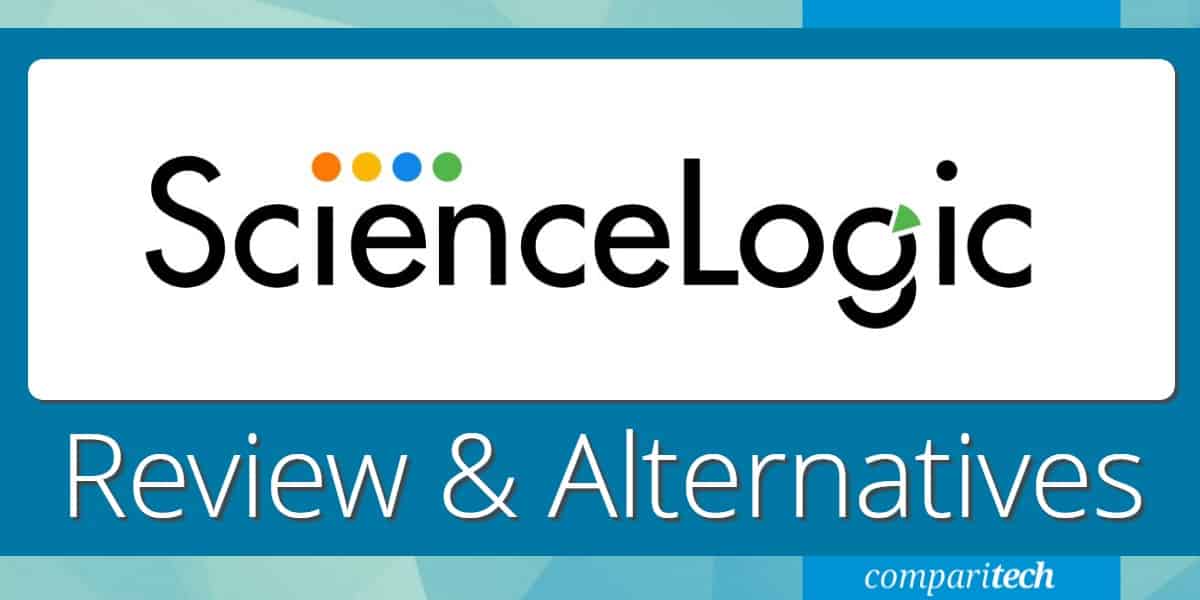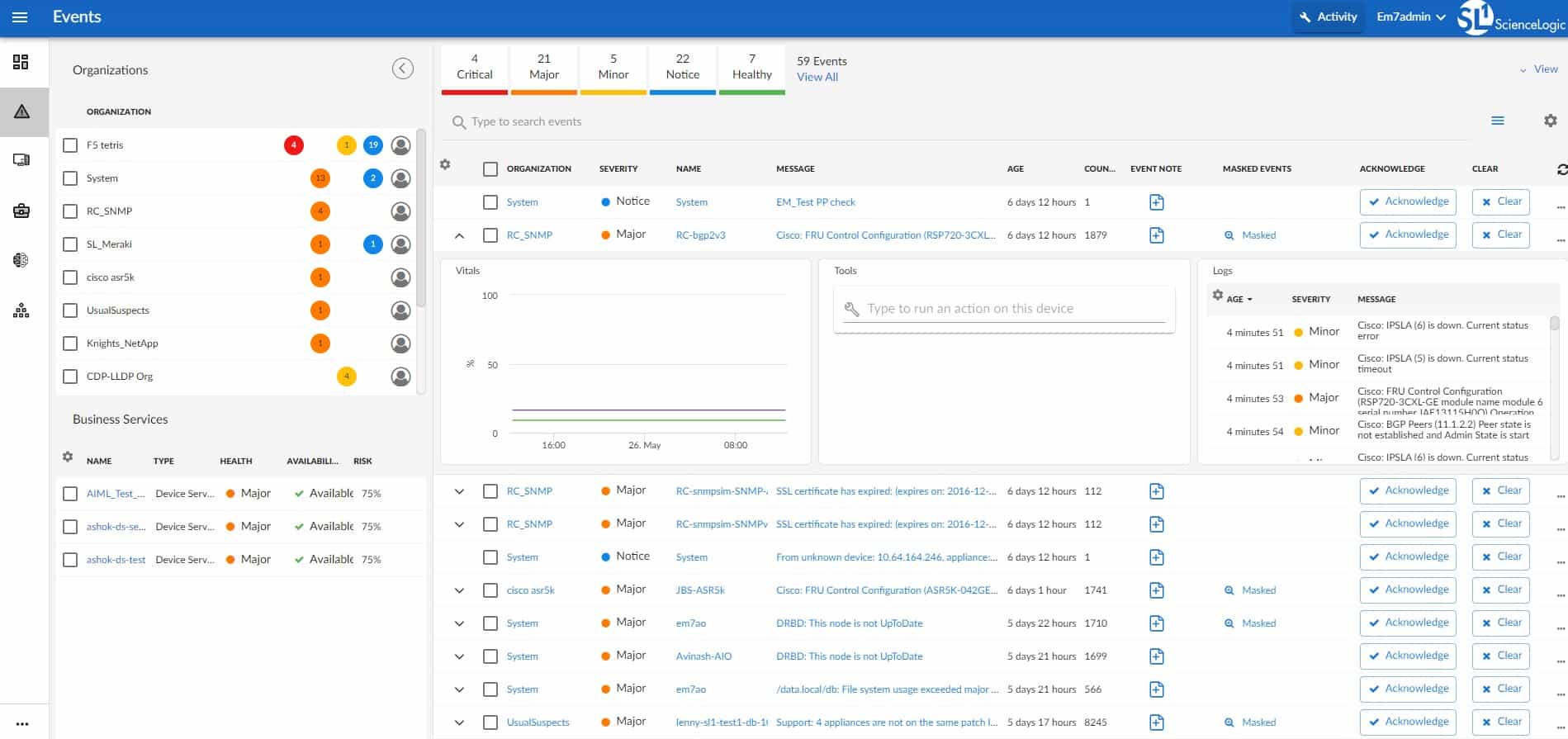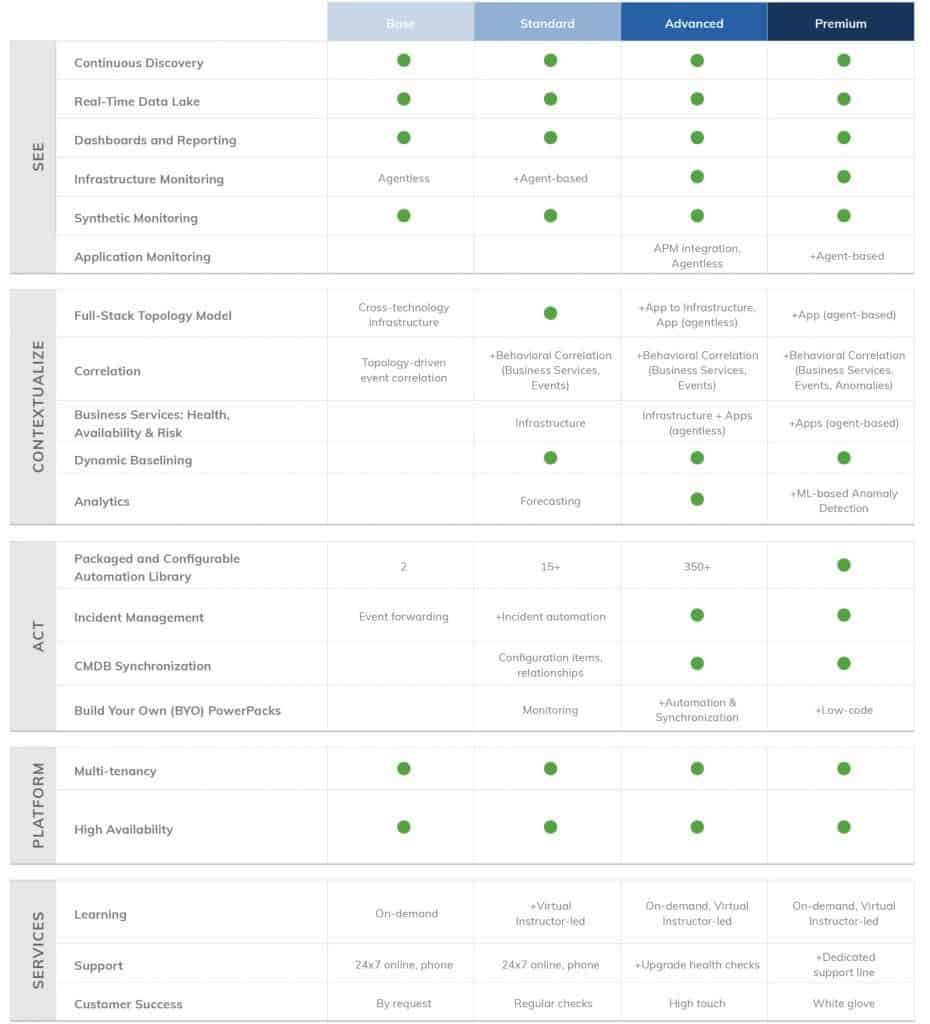ScienceLogic offers system monitoring and management services from its SaaS platform, which is called SL1. ScienceLogic classifies its service as “AIOps.” This means that it applies AI techniques to IT Operations tasks. Artificial Intelligence has many disciplines, and the specialization that is particularly useful for system monitoring tools is called Machine Learning (ML). The application of ML to system monitoring removes the need to fine-tune monitoring settings, particularly to the levels at which performance expectation thresholds are applied.
Using ML for performance thresholds means each business gets a monitoring system that automatically adjusts to its working practices. Thresholds trigger alerts when crossed, and if those levels are set for the needs of the average business system, many companies will get alerts when they don’t need them, or the system will allow performance to drop to a level lower than the company expects.
ML takes time to acquire its baselines by looking at regular activity over time. A downside to that strategy is that it takes time to find a suitable level of service for each of the metrics it observes. Once an initial baseline has been established, the learning process tweaks thresholds in response to further observations.
The advent of Cloud services and APIs makes resource usage more complicated. With service and application interdependency, the process of tracking system requirements gets more complicated. SL1 plots application dependencies and uses more AI processes to predict resource shortages and [processing bottlenecks.
About ScienceLogic SL1
ScienceLogic is based in Reston, Virginia, and it started its operations in 2003. Two of the company’s three founders are still leading the business. In addition, the company is still privately held, with investment funds being significant stockholders.
Over the years, ScienceLogic has developed a suite of system monitoring and management tools that integrate Machine Learning and are delivered from the Cloud.
Through development and acquisition, ScienceLogic has extended its capabilities, applying advanced technology to more areas of system performance tracking.
ScienceLogic SL1
The SL1 platform from ScienceLogic offers monitoring and management tools to supervise networks, servers, and applications. The system can monitor assets on-premises and on the cloud, and it is capable of looking after hybrid systems no matter where they are located.
The platform has a multi-tenanted architecture, which makes it suitable for managed service providers. In the multi-tenant scenario, one master account can set up many sub-accounts. However, the data held for the master account is kept isolated from the operating system. Hence, there is no way that the user of one account can get down into the operating system and break into the file space of another account. Similarly, the sub-account data is kept isolated so there can be no mixing of data, and access to one sub-account does not give access to any of the others.
Setting up sub-accounts is an option, and the SL1 system can be used by the IT Operations department of a multi-site organization to centralize monitoring and management.
The dashboard for the service is colorful and well organized. For example, the Events screen below illustrates the well-planned sectors that fill a typical screen.
The Events screen is a central part of all of the system monitoring modules in the ScienceLogic system. This displays what is usually known as “alerts.” These notifications are detected problems in the monitored system.
ScienceLogic segments its services by the categories:
- See – Monitoring and data gathering
- Contextualize – Event correlation (alerts) and analysis
- Act – Incident management and automated system maintenance processes
These functions project across all monitoring and management modules.
Network Monitoring
An essential function in the Network Monitoring module of the SL1 platform is its autodiscovery service. This gets into a network and searches for all attached devices. It seems that this system relies on the Simple Network Management Protocol (SNMP).
ScienceLogic performs agentless monitoring in its lowest plans and agent-based monitoring in higher plans. The SNMP system involves device agents installed by the equipment manufacturer to compile status reports and send them to a central controller. This pre-existing group of agents enables ScienceLogic to perform “agentless” monitoring.
The data gathered from network devices get processed by the ScienceLogic server into live reports on the system dashboard. Each metric, as it arrives, is checked against a threshold level to decide whether the report is within a safety margin or should trigger an alert.
Network Management
Although the SL1 platform is mostly about monitoring systems, there are some asset management functions in the package. For example, the autodiscovery service compiles an asset inventory for hardware and then scans each device to create a software inventory. The two databases of system information form the core of the monitoring system because they provide a list of assets to check.
SL1 also includes a network configuration manager, called Restorepoint, which standardizes the settings of network devices and then stores an example. This image can then be applied to new devices of the same make and model. The system constantly checks the configuration of each device, comparing it with the stored image. If a change has been made outside of the configuration management console, this is likely to be a hacker’s attempt to move about the network undetected. Restorepoint reapplies the stored image to wipe out those changes.
Server Monitoring
Server Monitoring is implanted through “integrations” in the SL1 platform. Integration is an add-on that loads extra screens and monitors into the system. There are integrations available for Linux, Windows, and Windows Server, but not macOS.
The system performance statistics gathered through these integrations are all compared to performance thresholds by the SL1 server, and they are shown live in the system dashboard.
The server monitoring system of SL1 also includes some system management functions, enabling maintenance automation scripts to be created for Windows and Linux.
Cloud Monitoring
Cloud Monitoring is another function that gets added to the SL1 monitoring service through integrations. Integrations avoid users being presented with a menu full of screens that they will never use because they relate to technology that the organization doesn’t use. Hence, the user adds on the functions that cater to the cloud platforms used for the monitored system.
There are integrations available for:
- Amazon Web Services and 36 specific AWS packages
- Microsoft Azure and 30 individual integrations for specific Azure services
- OpenStack
There are no integrations available for Oracle Cloud, Google Cloud Platform, or Alibaba Cloud.
Application and Infrastructure Monitoring
The Application and Infrastructure Monitoring capabilities of SL1 is ScienceLogic’s unique selling point. This is where the service applies its AI capabilities to the most excellent effect. When performing its autodiscovery routines to generate hardware and software asset inventories, the SL1 system also scans through running processes to identify applications and the services that support them.
As there can often be several layers of applications that support applications and services that support services, tracking these relationships is more complicated than just generating a list. SL1 uses investigative techniques to assemble a dependency map. The AI system uses this in the SL1 platform to work out when resource demands from all hidden processes behind applications could result in shortages. When software cannot get all the processor time, memory, and storage space that it needs, it either slows down or hangs. So, SL1 predictions can prevent that performance issue from arising.
The infrastructure assets that ScienceLogic monitors include virtualization systems. These monitoring services are implemented as integrations, and they are available for:
- Hyper-V
- VMWare
- NetApp
- Citrix Xen
- Kubernetes
- Docker
The applications that the SL1 system can monitor include databases, Web servers, file servers, and the Microsoft 365 productivity suite.
Synthetic Monitoring
ScienceLogic offers Synthetic Monitoring in all of its plans. This service implements periodic checks on websites and web services’ availability and response times through automated processes.
ScienceLogic deployment options
Although it is primarily marketed as a SaaS platform, it is also possible to get the code for the SL1 platform pre-installed on a network appliance on your site. The appliances have the Linux operating system. Unfortunately, ScienceLogic doesn’t give a list of its available appliances.
ScienceLogic prices
ScienceLogic doesn’t publish a price list for its SL1 SaaS platform or the network appliances that it offers. However, its services are organized into packages. These are:
- Base
- Standard
- Advanced
- Premium
As you would expect, these plans have increasing features and higher prices from Base up to Premium.
All plans include network, server, and cloud monitoring and management and synthetic monitoring tools to check website availability.
Application monitoring is only offered in the two higher plans. All plans provide a multi-tenancy architecture, and all include high availability with mirrored systems on the cloud to provide continuity. However, the majority of the AI processes of ScienceLogic are reserved for the two higher plans. You can see the full table of services per plan in the table below.
To get a price for your specific needs, you should contact the ScienceLogic Sales Department and request a quote. As part of your investigation into the suitability of ScienceLogic for your company, you can request a demo of the SL1 platform.
ScienceLogic strengths and weaknesses
ScienceLogic hasn’t settled its SL1 platform, and it is still adding on new features. However, the company is exceptionally skilled in improving efficiency by applying AI processes. As a result, we have derived several good points and bad points about the ScienceLogic SL1 platform.
Pros:
- Monitoring networks, servers, infrastructure, applications, and cloud resources
- Constant asset discovery and an automated asset inventory
- Alerts to spot performance issues
- AI processes to map application dependencies and spot resource demands
- Automatically adjusted performance thresholds
Cons:
- No option to install the system on an on-premises server
- No free trial
ScienceLogic alternatives
ScienceLogic’s SL1 platform is an exceptional monitoring service. It is suitable for medium, and large businesses use; plus, it offers a configuration ideal for use by managed service providers. In addition, the inclusion of AI processes to improve monitoring services is an excellent feature of this system. However, ScienceLogic is not the only player in the AIOps tools market. There are a few other ideal monitoring systems that you should consider before you opt for ScienceLogic.
Here is our list of the five best ScienceLogic alternatives.
- Datadog This SaaS platform is offered as a series of modules. However, they all fit together. By subscribing to the Network, Infrastructure, Database, and Synthetic Monitoring modules, plus the APM, and Incident Manager, you get the same functions offered by ScienceLogic – except the Configuration Management service. This service includes AIOps for application dependency mapping. Access a 14-day free trial of any or all Datadog modules.
- Dynatrace This cloud-based platform offers a choice of plans from complete stack monitoring to website testing. In addition, the service includes AIOps features to improve efficiency and accuracy. Add on Cloud Automation and Application Security to get the full benefit of this subscription service.
- LogicMonitor This application monitoring system includes infrastructure performance tracking, and it can consist of multiple sites and cloud platforms in one plan. This system uses AI processes and offers automated functions that match the features of ScienceLogic SL1.
- AppDynamics This cloud0-based system can deploy AI to map application dependencies and predict potential performance problems. As well as monitoring applications, this system tracks the performance of infrastructure, so you get visibility into the operations of front-end software back to server resources.
- Zenoss Cloud This monitoring service operates from the Cloud and offers full-stack system performance supervision, and it uses AI processes in its functions. Monitor networks, servers, virtualizations, services, and applications with this AI-driven package.
L’article ScienceLogic SL1 AIOps Review & Alternatives est apparu en premier sur Comparitech.



0 Commentaires